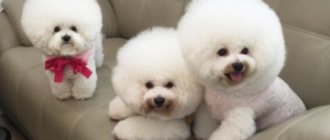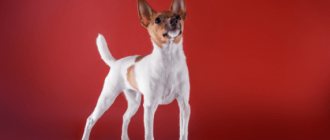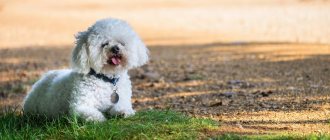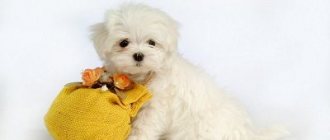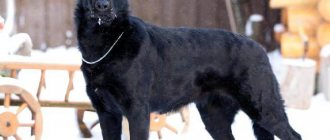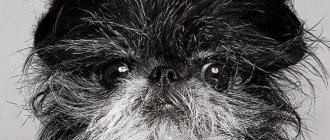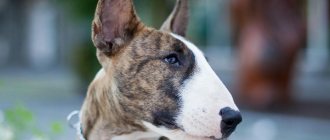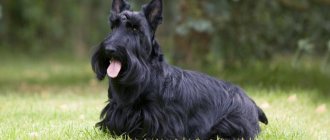The Bichon Frize or French lapdog is a small decorative dog that resembles a plush toy, which is characterized by the following features:
- spectacular appearance;
- fluffy curly white fur;
- friendly disposition;
- loyal attitude towards children;
- attachment to the owner;
- desire to always be in the center of attention;
- demanding care;
- ability to adapt to different conditions.
The name Bichon Frize translates to "Curly lap dog" and is short for "barbichon" (small spaniel). The Bichon Frize dog breed actually comes from the Water Spaniel (Barbet) and the Poodle. Since there is reason to believe that its homeland is France, the pet that looks like a white cloud is also called the French lapdog. It was created to help hunters, but is used exclusively as decorative.
Characteristics of the Bichon Frize dog breed
Male:
Bitch:
Price:
Lifespan: 15–20 years. |
Is it difficult to care for a Bichon? | They are not demanding when it comes to walking, but their fur and eyes require special attention. |
What climate suits them? | They react calmly to cold and heat. |
Where is it better for a Bichon to live: in an apartment or in a house? | They adapt to any living conditions, but this is a lap dog. |
How often should you bathe? | Water treatments are organized 1–2 times a month. |
Is grooming necessary? | The pet needs to be cut every 6-8 weeks. |
How often should you go for a walk? | Bichons do not need to be walked daily; they can be litter box trained. |
Does your pet need clothes? | No, this breed tolerates cold well. |
Are there any difficulties with parenting? | They are easy to train and enjoy training. |
What health problems might there be? | These are some of the healthiest dogs. |
Who is the breed not suitable for? | Bichons have a good sense of a person's mood and character. They behave as they are allowed, so they suit everyone. |
Can I buy for a child? | Yes, they are great with children. |
Is it possible for people without experience in keeping dogs to own one? | The Bichon has an easy-going character and is easy to train. Therefore, it is suitable for inexperienced owners. But its content is very complicated. |
What kind of work can they do? | These are decorative dogs, their purpose is to decorate a person’s life. But they often perform in the circus and show themselves well in agility. |
Can it be kept with other animals? | Bichons are peaceful, they do not enter into conflicts with cats and other dogs. They may well coexist together. |
Advantages of the breed
- They have short legs and a strong skeleton, which makes them excellent decorative dogs.
- They are of medium size (they are twice the size of other popular decorative dogs), you can play with them without fear of injury.
- They have an attractive, silky, curly white coat.
- People suffering from allergies can more easily tolerate dogs of this breed - they have dense fur that sheds little and has virtually no odor.
- These are active dogs with a cheerful character and are excellent companions.
- They are easy to train and love to learn different tricks.
- Friendly and playful, suitable for families with children.
- They are distinguished by longevity and boast good health.
Flaws
- A loud voice, and if not properly trained, excessive barking.
- The fur coat requires constant care.
- Regular haircuts are expensive.
- White wool makes walking in difficult weather conditions difficult.
Negative qualities
The disadvantage of the breed may be:
- Grooming needs;
- Eye problems;
- Tendency to allergies;
- Noisy behavior.
The coat of purebred individuals requires careful care. The white cover is constantly getting dirty. If your dog is rarely bathed, the coat will begin to darken. To prevent tangles from forming, your pet will have to be combed every day. Once a month a haircut is required, otherwise the lapdog will become overgrown and will look like a mongrel and not a purebred individual. It is difficult to do this dog's haircut yourself; you will have to go to a dog salon. Full care of a lap dog's coat requires time and money.
Bichon Frizes often have eye problems. There is a tendency to cataracts, leading to loss of vision. You need to monitor the condition of your eyes, and if you notice any alarming signs, contact your veterinarian immediately.
The breed is prone to allergies. Food allergies often occur. The owner must choose the right diet for the pet. Sometimes this takes time and costs. An allergic reaction in an animal is often manifested by dermatitis, eczema and other skin pathologies.
Lapdogs love to bark shrilly. Male and female are equally noisy. By barking they express joy or displeasure. Loud barking can displease neighbors. The dog must be weaned off from displaying a violent reaction immediately. With the right approach, the animal's behavior can be corrected.
Photo of Bichon Frize
Dog character, behavior
The fluffy Bichon could be called an ideal lap dog, if not for its complex coat care. He is playful, loves the company of people, affectionate, and quickly gets used to his new home. The pet has an easy-going character, he loves children and even gets along well with other animals. He is not vindictive, he is not malicious and will not play dirty tricks without reason.
The inquisitive four-legged baby is ready to play all day long, and is not averse to taking a training course. For him, training is one of his favorite activities. The dog is easy to train. He quickly masters basic commands, and if desired, he can be taught interesting tricks.
Behavior at home
Bichons are extremely sociable little ones. They love to play with children, behave tenderly and carefully with them, and tolerate their pranks. As a rule, they do not show aggression. They feel great even in a tiny apartment. The breed is distinguished by its quick wit and high intelligence.
This breed is not suitable for outdoor living. Firstly, the snow-white fur will suffer greatly from this, and secondly, it is important for them to always be aware of all events in the family. Human interaction is very important for the Bichon Frize breed. Reviews from owners and breeders confirm this.
The Bichon's habits are noble, as befits people from royal palaces. A pet is never annoying. If the owners want to relax, he will not pester them with games. He will lie next to you, looking furtively - has the mood of his beloved owner changed?
Behavior on the street
Ideally, dogs of all decorative breeds should spend at least a little time outside every day. This also applies to the Bichon Frize. The description of the breed contains data on the purity of the breed. But you shouldn't abuse it. Kids love to go for walks. This is entertainment for them. On the street, pets prefer to play with the owner and with children; they react calmly to strangers.
Attitude towards strangers
What a bichon will not do is guard the house. This role does not suit him. He can bark to notify of the approach of a stranger, but the baby will not be able to perform the functions of a full-fledged watchman.
Appearance: pros and cons
The beauty and charm of the Bichon Frize simply knocks you off your feet. This often misleads those thinking about getting a pet. The brilliant exterior stubbornly insists: the frieze is the ideal choice. But don’t rush: behind the appearance of the French snow-white angels lies a number of shortcomings of the ancient breed.
The coat of the Bichon Frize is an undoubted achievement and success of centuries-old selection. The most delicate, slightly wavy coat does not have a thick, downy undercoat, is not subject to seasonal shedding and does not cause allergic reactions. All this is the positive side of the issue of appearance.
You have to pay for everything: caring for the coat of curly-haired snow whites is a complex and responsible set of measures. Not only the dog’s silky coat, but also the dog’s skin requires the owner’s close attention. Like most lap dogs, Bichon Frizes are susceptible to allergies and skin inflammation.
Grooming for Frize dogs includes:
- regular washing and bathing;
- thorough daily combing, removing tangles;
- treatment of eyes and tear ducts;
- trimming claws;
- wiping the ears and trimming the ear canals;
- control and cleaning of teeth.
The most important event is a monthly hygienic haircut: in addition to cutting the main coat, the pet’s paw pads and intimate areas are treated.
All of the above applies only to dogs that do not participate in exhibition activities. “Competitive” dogs need more thorough, full of secrets and subtleties, and therefore very expensive procedures of professional grooming centers.
The appearance of the Bichon Frize is an indisputable advantage of the breed, which requires constant effort, time and financial investment. Complicated and “non-budget” grooming is undoubtedly a “minus” of the breed .
Bichon Frize care: coat, eyes, ears
Caring for representatives of the breed is complicated by the peculiarities of the coat. The fur coat needs to be washed frequently, the wool needs to be combed and trimmed periodically. Significant efforts are also needed to combat darkening of the coat. Stains may appear as a result of contamination. But sometimes this is a manifestation of a disease or a consequence of improper care.
Special bleaching products for dogs help maintain the whiteness of the coat. These are lotions, balms, rinses, sprays, powders. Sometimes stains can be removed with a cotton swab soaked in 3% hydrogen peroxide. Apply it for 5 minutes, then remove with a dry cloth and dry the area with a hairdryer. After this, you need to apply whitening powder. It is important to ensure that the drug does not get into the eyes, ears and mouth.
Eye hygiene
I cut off the hair near the eyes. Use a damp cloth to wipe your eyes every day. Otherwise, the secretion will get on the fur, leaving unwanted stains on the fur coat. If yellow and green discharge appears, the dog should be taken to the veterinarian. These may be manifestations of eye diseases.
Ear hygiene
The ears are cleaned every week with cotton swabs and a special product. The hair around the ear canal is trimmed. Hair growing inside the passage is plucked out with tweezers. This does not cause pain to pets, because there are few nerve endings in the auricle.
Dental care
Teeth are examined weekly. When plaque appears, it is removed with a soft brush and special tooth powder. You can give your pet special dry granules that remove plaque. You need to make sure that there is no food left between the teeth, because it is food for pathogenic bacteria.
Nail care
Bichons rarely walk on asphalt or other hard surfaces, so they do not wear down their claws enough. They have to be trimmed. They do this with a nail clipper. You need to act carefully so as not to damage the living tissue of the nail where the blood vessels are located.
Bichon haircut
The hair of this breed grows constantly, like that of a human. Therefore, according to the standard, haircuts are allowed. The groomer's task is to shape the head into a ball or bell. Ears, beard and mustache are trimmed. The body is also subject to haircut. It should look elegant and slender. To do this, hair is cut on the lower back and sides, but no closer than 3 cm to the skin. The lower part of the belly is left covered with fur. The paws are shaped into a cylinder; the tail is not trimmed.
Grooming a Bichon Frize is a common thing for breeders. They usually do it themselves. Inexperienced owners will have to learn this or constantly turn to the services of groomers. Pets need to be cut at least once every month and a half, sometimes you have to do this monthly as the fur grows back.
Washing and bathing
You need to bathe your dog as needed, usually once every 1-2 weeks. The wool is quite dense and takes a long time to dry. It needs to be dried with a hairdryer, but the puppy is accustomed to this procedure from childhood. Wet wool increases the risk of colds and fungus on the skin.
After each walk, they wash their paws, and after eating, their face. Tangles should not be allowed to appear. To do this, the dog is combed after each bath. This should be done especially carefully during periods of increased mat formation - during the puppy’s coat change (7–9 months) and during the period of growing up (1.5–2 years).
Walking and exercise
In foreign nurseries, special open areas are built for walking Bichons. Our owners of white lumps face problems. After a walk on dusty asphalt, the fur coat loses its whiteness, and in slush and rain it can suffer greatly.
The best place for walking is a low lawn. There the baby can run around to his heart's content without spoiling the fur. In bad weather, you don’t have to take your pets outside at all. They quickly get used to the tray. But you can’t do without physical activity. A walk is not only an opportunity to solve physiological needs, but also communication, socialization, and physical development of the puppy.
Tendency to diseases, vaccinations
Pets have good health, but they are predisposed to the following diseases:
- diabetes;
- allergy;
- dermatitis;
- epilepsy;
- urolithiasis disease;
- atlantoaxial subluxation;
- dislocation of the kneecap;
- hypotrichosis;
- eye diseases (cataracts, corneal dystrophy);
- congenital deafness;
- inversion of the eyelids (entropion).
Pets may suffer from infectious diseases: enteritis of various etiologies, kennel cough (canine flu) and others. Many dangerous diseases can be avoided by wisely using vaccination.
Vaccinations, anti-worming treatments
The choice of vaccine depends on the epidemiological situation in the region and the veterinarian. Pathogenic microorganisms and viruses constantly mutate. Therefore, vaccination should be carried out with drugs that are most effective against pathogens present in a given region.
Puppies born from vaccinated bitches have maternal antibodies. This is why it is so important to check the mother’s veterinary passport when purchasing. But as the baby grows up, he loses some of these antibodies. By 2–3 months their number approaches zero. Therefore, vaccination begins at 6–8 weeks. Revaccination is carried out at intervals of 2–4 weeks.
Bichons are more often vaccinated with the French vaccine and the Dutch Nobivak series. The vaccination regimen is chosen by the doctor. Each vaccine has instructions for use. Using multicomponent drugs, you can build a step-by-step scheme that will protect your pet from plague, hepatitis, parvovirosis, parainfluenza, leptospirosis, rabies (Nobivak labeled DHPPi+LR).
It is important to protect your pet from parasites. Anthelmintic drugs are given before vaccination. For ticks and fleas, you can use drops on the withers (they do not spoil the coat) or wear a special collar.
What to feed
It is convenient to feed small toy dogs with high-quality ready-made diets. Dry food of at least premium class is suitable. They provide complete nutrition. You can switch your pet to natural feeding. But in this case, you will have to carefully calculate the portions and additionally give vitamins and supplements for the coat. This requires enormous effort from the owners. Therefore, they often choose dry food or a mixed type of feeding (ready-made diets and some natural products - meat, offal, vegetables).
Puppy diet
The puppy's feeding schedule depends on its age. The smaller it is, the more often it is fed (from 3 to 5 times a day). They do this strictly at a certain time. Leftovers are always removed. Only water should always be freely available. By the age of 1–1.5 years, the puppy is transferred to 2 feedings a day.
Adult dog diet
Adult dogs are given food 2 times a day. You can’t do this before a walk and immediately after it. The food is carefully chosen. Some types of ready-made diets cause increased lacrimation, which is extremely undesirable. The breed often suffers from allergies, so you need to choose a food that does not cause them.
It is necessary to monitor the weight of pets, they are prone to overeating. You can notice the problem by looking at the maklaks. These are bones in the croup area, a kind of “waist” of dogs. It should be palpable well. If maklaki are difficult to find, it means that obesity has begun.
The purpose and character of the Havanese Bichon
Havaneses are decorative, indoor dogs that are convenient and pleasant to keep in small apartments. Representatives of this breed are ideal for lovers of small dogs and can become wonderful companions who will love them with selfless love. Havanese Bichons, in many ways, fit the title of “glamorous” dogs.
But their simple and cheerful disposition is very far from aristocracy. Due to the cheerful nature , openness and liveliness of Bichons, they are often used in so-called animal therapy.
Havanese Bichons, unlike most other small breeds, have an extremely outgoing personality. These dogs are easy to train and always have a cheerful and playful attitude . It is because of this character trait that Havanese dogs were previously used for circus performances. Bichons love children very much , show endless affection towards them and can play as much as they want. They get along well with other pets.
These dogs become very attached to their owners and are ready to accompany them everywhere and at any time. Havaneses are social dogs and without human company they become very sad and feel discomfort. They love to be praised and are very sensitive to their owner's tone. When they are praised, they begin to jump and wag their tail. But if they scold, they pretend to be guilty and prefer to hide from the eyes of the angry owner.
Havaneses can be easily frightened , but mask their fear with playfulness. At the same time, these dogs love to be taken into account and are offended when they are treated with excessive severity or unceremoniousness. Although these are small decorative dogs, they have excellent hearing and are quite capable of performing the functions of a watchman.
Training and education
Smart white lumps learn quickly. They need to be taught to maintain cleanliness. To do this, pets are praised when they do their business in the right place. Remember that it is difficult for a baby trained to use a tray to get used to the outdoor toilet. It is especially not necessary to accustom male dogs to the “diaper”. They have difficulty distinguishing between different types of toilets, and may confuse latrines with corners that are not intended for this purpose.
Representatives of the breed may bite during play. They do this kindly, but it is better to wean them off such behavior. To do this, the person freezes and does not look into the eyes after the bite. The puppy must understand that his behavior causes pain to the person. You cannot pet the dog at this moment.
If you plan to take your pet for walks in the city, train him to use a leash. First, the baby must get used to the collar, then accustom him to the new accessory. They do this at home, and only then take them outside. By this time he should have mastered the basic commands: “No”, “Come to me”, “Near”, “Sit”.
Choosing a Havanese puppy
- Havanese Bichon babies have an interesting feature: puppies of completely different colors can be born in one litter. The potential owner can choose a pet according to his taste, but in addition to the coat color, he must meet the breed standard and be in good health.
- A healthy Havanese Bichon puppy is usually adopted out to a new family when it is two to three months old. At this age, babies still have quite short fur, but it is already possible to trace some of the existing shortcomings and defects. For example, the pigmentation of the nose and eyelids should be black; there is no need to hope that over time a spotted nose or pink eyelids will turn black, as required by the standard.
- The paws of babies should be strong and strong, even, without curvature or markings. The eyes are clear, not bulging or sunken in the sockets, clean, without tears on the muzzle. Reddened eyes or copious discharge from them indicate pathology.
- The Havanese Bichon puppy is a fun little guy who actively explores the world. A baby that is shy, timid, or sitting passively in the corner of the room may be sick or have a temperament that does not match the breed.
Choosing and caring for a puppy
Only a specialist can distinguish a Bichon Frize puppy from many other fluffy dogs with white fur. Therefore, you can only buy purebred babies from a nursery with a good reputation. A prerequisite is the presence of documents. Don't take the word for information in advertisements. Potential buyers are lured by loud statements that the puppy’s parents are champions, the litter is registered, and the baby has great potential.
Main components of choice:
- breeding value;
- puppy's exterior;
- quality cultivation.
Breeding value analysis
The information must be checked, otherwise there is a risk of buying an animal that turns out to be far from the standards of the Bichon Frize breed. Price does not always indicate breed. This often affects novice breeders who believe that their babies are the best. You need to look at the pedigree of the mother (and preferably also the father), veterinary passport, mating certificate, exhibition diplomas, then check the brand. It is better to take a specialist with you to the viewing.
Inspection of the litter (certification) is carried out every 45 days. After the examination, a puppy card is issued (the pedigree is issued later, to the new owner), and the breeder issues a veterinary passport. Puppies move to a new home at the age of 3 months; it is not recommended to take them earlier.
Puppy exterior
Only a puppy born as a result of breeding can meet the standard. Thoughtless breeding leads to the degeneration of the breed. If you are interested in your pet's future exhibition career, use the services of an experienced dog handler when choosing.
A puppy up to 3 months old looks strong, he has a harmonious, proportional physique. The gait is confident, without wobbling from side to side. The exterior will be fully formed by 1 year, and the head and chest will be formed until 2.5 years.
Puppy color
The standard color of the coat is white, but a Bichon Frize puppy may have cream spots on the ears and body. By the age of one year they usually disappear. The nose is highly pigmented - it should be completely black. The eyes are also well painted.
What should you pay attention to when choosing a puppy?
The breeder should be extremely interested in you as a new owner, give detailed instructions, ask questions about the conditions and experience of caring for the dog. If the dog breeder answers briefly or finds it difficult to answer some question about maintenance, try not to contact him.
Breeders do not sell puppies under 3 months of age
- Inspect the room in which the dogs live, it should be clean, bright and fresh, the dogs should be active and happy.
- Study the appearance of the bitch and the stud dog. Check the mating certificate, pedigree, veterinary passport, brand.
- If parents have titles, ask for confirmation: awards, certificates and diplomas.
- Then look at the puppy card issued by the Russian Canine Federation. It will give you the opportunity to participate in all RKF exhibitions.
- The last vaccination in the veterinary passport should be no more than a week ago, and the brand must match the brand on the puppy itself.
- Make sure that the breeder has sufficient rights to sell the puppy, and that the acts of sale and acceptance are completed correctly.
- After checking the documents, talk to other pets, observe them, evaluate their behavior: they should not be lethargic, fearful, hyperactive, too loud or aggressive.
The Bichon Frize will make a great friend and companion.
- Be sure to ask the breeder questions about the dog’s character, hereditary diseases, features and exterior flaws.
- If you want to participate in shows or breed Bichons, but do not have enough experience, do not hesitate to invite an independent expert who will determine compliance with the breed standard to avoid deception.
- The breeder must give you the most detailed recommendations on feeding, care, transportation (certificate F1), and preparation for exhibitions.
Example of F1 form certificate
Bichon Frize breed standards (FCI Standard No. 215)
| FCI classification | Group 9 – Companion and decorative dogs. Section 1 – Bichons and related breeds |
| Usage | Companion dog |
| Appearance | A small cheerful dog with loose, white fur in curls. The curls are shaped like a corkscrew. The length of the body is greater than the height at the withers. |
| Temperament, behavior | Muzzle. The cheeks are flat and not very muscular. The transition from forehead to muzzle is smoothed. The furrow between the eyebrows is slightly noticeable. The forehead is flat to the touch. |
| Head |
|
| Frame |
|
| Limbs |
|
| Movements | Fast, free, paws move in parallel. |
| Wool | Long, thin, silky. The outer hair has spiral curls. The undercoat is thick and soft. I trim the fur along the body and give the head a ball shape. |
| Color | White. |
| Height | Height at the withers is 25–29 cm. In males, the height can be 1 cm higher, in females – 2 cm lower. |
| Flaws | Deviation from the above parameters is a disadvantage. |
Character
The Havanese Bichon is distinguished by its flexibility and high mental abilities. Shows healthy wariness towards strangers, but is devoid of aggression. A decorative dog requires indoor keeping. An ideal option for a pet whose maintenance is planned in small rooms, small apartments.
They require increased attention from the owner and family members. Alone, he will feel sad and show his sadness by damaging things. Therefore, it is not advisable to leave the dog alone for a long time, especially at night.
Origin story
The breed appeared in the Mediterranean in the 14th century, although white dogs were found even before our era. The birthplace of the breed is considered to be France and Belgium. At first, Bichons were considered rat hunters. But a number of features determined their future fate. Their touching appearance made them mega popular. During the Renaissance, dogs that looked like a fluffy cloud lived in the courts of monarchs. They were called little princes. Proof of this is their presence in portraits of the nobility of that era.
Only several centuries later they migrated from palaces to ordinary Europeans. They performed on stage, accompanied traveling actors and worked as guides. Now he is the star of cynological shows around the world.
The dogs received their modern name Bichon a poil frise in 1978, in the same year they were recognized as a French-Belgian breed. Before that they were called Tenerife lap dogs. The French Kennel Club approved the first breed standard, replacing the name “Tenerife” (tenerife) lapdog (bichon) with “curly” (frise).
We have been breeding the breed recently. However, at world exhibitions you can already see domestically bred dogs, and they are not inferior either in the quality of the livestock or in grooming.
A little history
The mission that falls to the lot of this little dog is to bring joy to the family, live in apartments, wear fashionable accessories and proudly accompany its owners. This is the way it is now, but if you look at history, you can see that in the 16th century everything was different. People did not have the opportunity to keep pets if they did not bring benefits with their work. The historical homeland of the Bichon Frize dog is the territory of the Canary Islands. Now it is an autonomous republic. It was here that large dogs lived, valuable to people due to their strength and endurance.
Due to the fact that rodents were destroying food, people taught small dogs the skills of hunters. For the ancestors of the modern lapdog, it was an honor to serve on a merchant ship, where they safely cleared the holds of mice and rats. The described rat-catching dogs had a white, curly, light-textured coat. Since the peculiarity of white color is the reflection of heat rays, this makes it possible to maintain body temperature.
Curly and light wool is well blown by the wind, but it is protected from moisture. And such properties contribute to the process of self-cooling. It is also noteworthy that in translation the Canary Islands are called the Dog Islands. The autonomy's coat of arms is decorated with two dogs. Sailors constantly managed to sell dogs when visiting other continents. Therefore, “curly hair” soon appeared in many countries.
King Francis I made such dogs a privilege for the nobility. The breed was named infant, which translated sounded like “prince.” Henry III also created a stir around Bichon Frize dogs, instructing his servants to make special carriers so that he could walk everywhere only with his dogs. Small dogs have achieved dizzying popularity thanks to a new fashion trend. Every self-respecting court lady or high-ranking official should have had such a four-legged friend.
Among the French, white curly dogs were especially valued. Today it is fashionable to carry small dogs in your arms, but in the times of kings it was customary to bathe with these animals, since the nobility were attacked by lice, fleas and bedbugs. Therefore, the first lap dogs had the mission of attracting parasites.
